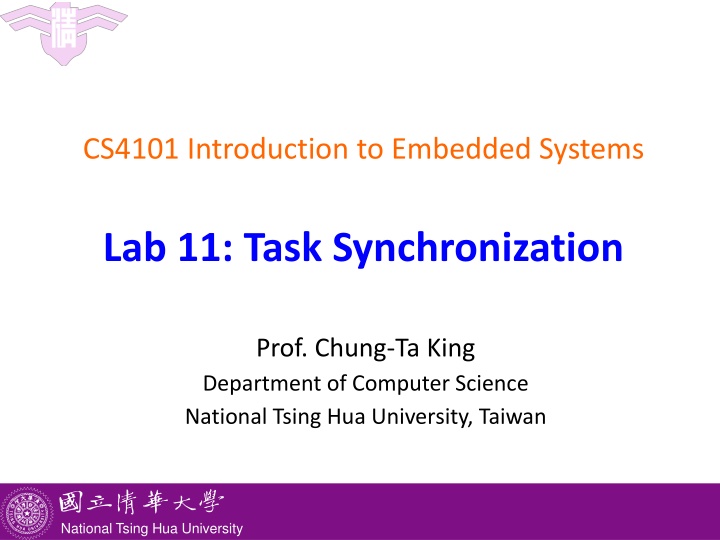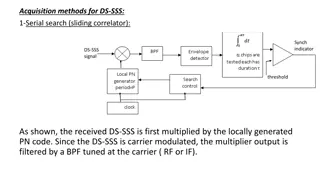
Task Synchronization in Embedded Systems Lab - Counting Semaphores and Mutex Example
Learn about task synchronization using counting semaphores and mutex in an Embedded Systems Lab. Explore how to implement shared spaces with semaphores on Arduino. Understand the concepts of counting semaphores and mutex for efficient resource management and mutual exclusion in embedded systems programming.
Download Presentation

Please find below an Image/Link to download the presentation.
The content on the website is provided AS IS for your information and personal use only. It may not be sold, licensed, or shared on other websites without obtaining consent from the author. If you encounter any issues during the download, it is possible that the publisher has removed the file from their server.
You are allowed to download the files provided on this website for personal or commercial use, subject to the condition that they are used lawfully. All files are the property of their respective owners.
The content on the website is provided AS IS for your information and personal use only. It may not be sold, licensed, or shared on other websites without obtaining consent from the author.
E N D
Presentation Transcript
CS4101 Introduction to Embedded Systems Lab 11: Task Synchronization Prof. Chung-Ta King Department of Computer Science National Tsing Hua University, Taiwan National Tsing Hua University
Outline In this lab, we will learn... Quick review of counting semaphore and mutex More sensors: RFID, IR Remote How to implement a shared space between multiple tasks on Arduino using semaphores? 1 National Tsing Hua University
Counting Semaphores Typically used for two things: Counting events: An event handler will 'give' a semaphore each time an event occurs, and a handler task will 'take' a semaphore each time it processes an event Resource management: The count value indicates number of available resources To get a resource, a task must obtain (take) a semaphore When a task finishes with the resource, it 'gives' the semaphore back SemaphoreHandle_t xSemaphoreCreateCounting( UBaseType_t uxMaxCount, UBaseType_t uxInitialCount) 2 National Tsing Hua University
Counting Semaphore Example (1/2) xSemaphoreHandle count_sem; //Global Handler int main(void){ // Parameter for uxMaxCount, uxInitialCount count_sem = xSemaphoreCreateCounting(2, 2); // Create tasks with priority 1 for both users xTaskCreate(task1, (signed char*)) t1", 1024, NULL, 1, NULL); xTaskCreate(task2, (signed char*)) t2", 1024, NULL, 1, NULL); vTaskStartScheduler(); return 0; } 3 National Tsing Hua University
Counting Semaphore Example (2/2) void task1(void *p){ while(1){ if(xSemaphoreTake(count_sem, portMAX_DELAY)){ xSemaphoreGive(count_sem); } vTaskDelay(3000); } } void task2(void *p){ while(1){ if(xSemaphoreTake(count_sem), portMAX_DELAY){ xSemaphoreGive(count_sem); } vTaskDelay(3000); } } 4 National Tsing Hua University
Mutex Mutexes are used for mutual exclusion, so that only one task at a time uses a shared resource, e.g., file, data, device, ... To access the shared resource, a task locks the mutex associated with the resource The task owns the mutex until it unlocks the utex 5 National Tsing Hua University
Mutex Mutex acts like a token used to guard a resource When a task wishes to access the resource, it must first obtain ('take') the token When the task has finished with the resource it must 'give' the token back - allowing other tasks the opportunity to access the same resource Mutex may cause a high priority task to be waiting on a lower priority one Even worse, a medium priority task might be running and cause the high priority task to not meet its deadline! Priority inversion problem 6 National Tsing Hua University
Priority Inversion: Case 1 Assume priority of T1 > priority of T9 If T9 has exclusive access, T1 has to wait until T9 releases resource inverting priority can raise priority of T9 T1 has higher priority and preempts T9 Critical section (critical section) 7 National Tsing Hua University
Priority Inversion: Case 2 A medium-priority task preempts a lower-priority task which is using a shared resource on which a higher priority task is blocked If the higher-priority task would be otherwise ready to run, but a medium-priority task is currently running instead, a priority inversion is occurred 8 National Tsing Hua University
Solving Priority Inversion Priority inheritance If a high priority task blocks while attempting to obtain a mutex (token) that is currently held by a lower priority task, then the priority of the task holding the token is temporarily raised to that of the blocking task 9 National Tsing Hua University
Example of Mutex (1/3) include <semphr.h> SemaphoreHandle_t gatekeeper = 0; //Global handler void user_1(void *p){ while(1){ if(xSemaphoreTake(gatekeeper, 100)){ Serial.println("User 1 got access"); // enter critical section vTaskDelay(200); //stay in C.S. for 200 ticks xSemaphoreGive(gatekeeper); // release semaphore, exit critical section } else{ Serial.println( User 1 cannot access in 1000 ms"); } vTaskDelay(100); // or do other works // Without delay, user 1 will get key immediately// } } 10 National Tsing Hua University
Example of Mutex (2/3) void user_2(void *p){ while(1){ if(xSemaphoreTake(gatekeeper, 100)){ Serial.println("User 2 got access"); //critical section xSemaphoreGive(gatekeeper); //release semaphore, exit critical section } else{//fail to get the semaphore Serial.println("User 2 cannot access in 1000 ms"); } vTaskDelay(100); // or do other works // Without delay, user 2 will get key immediately after releasing the key // } } 11 National Tsing Hua University
Example of Mutex (3/3) void setup(){ Serial.begin(9600); gatekeeper = xSemaphoreCreateMutex(); // Create tasks with priority 1 for both users // xTaskCreate(user_1, (const portCHAR*)"t1", 128, NULL, 1, NULL); xTaskCreate(user_2, (const portCHAR*)"t2", 128, NULL, 2, NULL); Serial.println("test"); vTaskStartScheduler(); } void loop() { ... } 12 National Tsing Hua University
Outline In this lab, we will learn... Quick review of mutex More sensors: RFID, IR Remote How to implement a shared space between multiple tasks on Arduino using semaphores? 13 National Tsing Hua University
IR Remote 14 National Tsing Hua University
Sample Code: IR Remote #include <IRremote.h> int RECV_PIN = 2; // set digital 2 to be receive pin IRrecv irrecv(RECV_PIN); decode_results results; void setup() { irrecv.enableIRIn(); // Start the receiver Serial.begin(9600); } void loop() { int i=0; if (irrecv.decode(&results)) { translateIR(); // see http://ppt.cc/GwLey irrecv.resume(); // Receive the next value } } 15 National Tsing Hua University
RFID-RC522 Go to https://github.com/miguelbalboa/rfid to download the library and unzip the folder to //Arduino/libraries 16 National Tsing Hua University
Sample Code: RFID-RC522 #include <SPI.h> // header for SPI bus #include <MFRC522.h> #define RST_PIN 9 #define SS_PIN 10 MFRC522 mfrc522(SS_PIN, RST_PIN); // Create Object void setup() { Serial.begin(9600); Serial.println("RFID reader is ready!"); SPI.begin(); mfrc522.PCD_Init(); // initialize FRC522 module } 17 National Tsing Hua University
Sample Code: RFID-RC522 void loop() { // check if there is a new card if (mfrc522.PICC_IsNewCardPresent() && mfrc522.PICC_ReadCardSerial()) { byte *id = mfrc522.uid.uidByte; // get new card UID byte idSize = mfrc522.uid.size; // get UID length Serial.print("PICC type: "); MFRC522::PICC_Type piccType = mfrc522.PICC_GetType(mfrc522.uid.sak); Serial.println(mfrc522.PICC_GetTypeName(piccType)); Serial.print("UID Size: "); // print length of UID Serial.println(idSize); for (byte i = 0; i < idSize; i++) { // print UID Serial.print("id["); Serial.print(i); Serial.print("]: "); Serial.println(id[i], HEX);} mfrc522.PICC_HaltA(); // stop the card } } 18 National Tsing Hua University
Outline In this lab, we will learn... Quick review of mutex More sensors: RFID, IR Remote How to implement a shared space between multiple tasks on Arduino using semaphores? 19 National Tsing Hua University
Basic 1 (40%) Make the IR remote to be interrupt-driven Whenever the IR remote is pressed, an interrupt is generated, which wakes up a read-digits task using a binary semaphore. The read-digits task will read 4 consecutive digits from the IR remote and print them on the LCD display. (Ignore keys that are not digits.) Do the same to RFID-RC522 using a read-id task, except that the task prints the card UID instead. 20 National Tsing Hua University
Basic 2 (60%) Instead of letting read-digits and read-id tasks print to the LCD display, let them write to either one of two buffers. Each buffer is an array that can hold 10 characters Create a display task will read the text from the filled buffer and print it on the LCD display. Create yet another task, read-char, that will write to the buffer with aaaaa and bbbbb alternatively every second. Use counting semaphores to allow data communicated between sender and receiver tasks. 21 National Tsing Hua University


